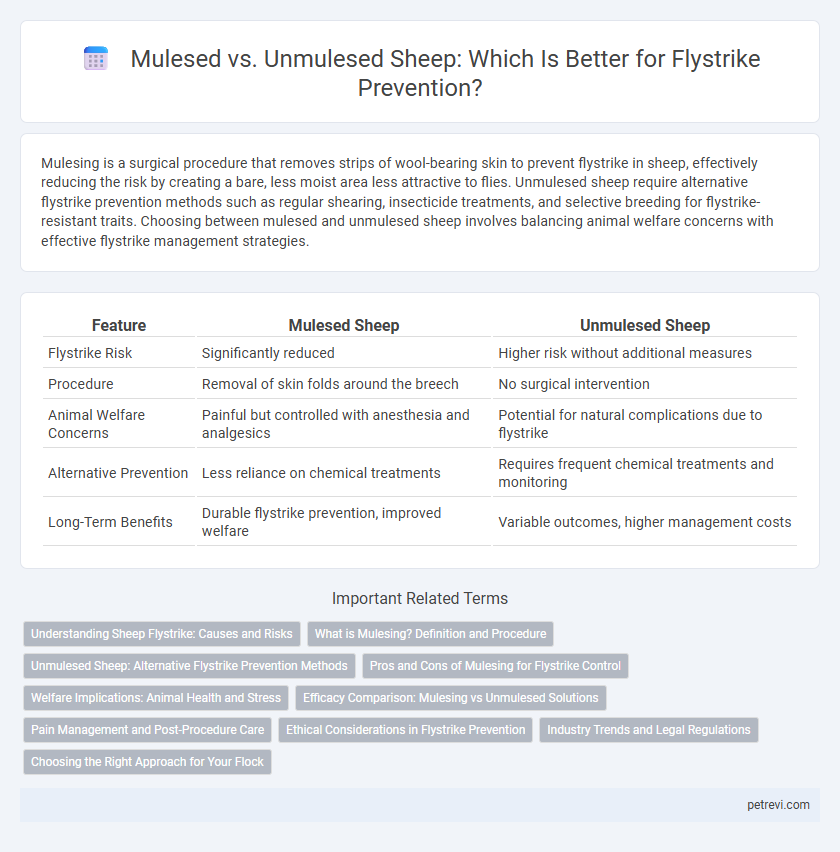Mulesing is a surgical procedure that removes strips of wool-bearing skin to prevent flystrike in sheep, effectively reducing the risk by creating a bare, less moist area less attractive to flies. Unmulesed sheep require alternative flystrike prevention methods such as regular shearing, insecticide treatments, and selective breeding for flystrike-resistant traits. Choosing between mulesed and unmulesed sheep involves balancing animal welfare concerns with effective flystrike management strategies.
Table of Comparison
| Feature | Mulesed Sheep | Unmulesed Sheep |
|---|---|---|
| Flystrike Risk | Significantly reduced | Higher risk without additional measures |
| Procedure | Removal of skin folds around the breech | No surgical intervention |
| Animal Welfare Concerns | Painful but controlled with anesthesia and analgesics | Potential for natural complications due to flystrike |
| Alternative Prevention | Less reliance on chemical treatments | Requires frequent chemical treatments and monitoring |
| Long-Term Benefits | Durable flystrike prevention, improved welfare | Variable outcomes, higher management costs |
Understanding Sheep Flystrike: Causes and Risks
Sheep flystrike is caused by blowflies laying eggs on damp, soiled wool, leading to maggot infestation and severe tissue damage. The risk increases in sheep with wool contaminated by urine or feces, especially in areas prone to wet weather and poor fleece hygiene. Mulesed sheep have surgically removed skin around the breech to reduce wrinkles and moisture, lowering flystrike risk, while unmulesed sheep require alternative preventative measures like regular crutching and insecticides.
What is Mulesing? Definition and Procedure
Mulesing is a surgical procedure performed on sheep, primarily Merino breeds, involving the removal of strips of wool-bearing skin from around the breech area to reduce flystrike risk. This process creates scar tissue that resists moisture and fly larvae infestation, significantly decreasing the likelihood of flystrike caused by blowflies laying eggs in moist wool. The procedure is typically carried out without anesthesia shortly after lambing to mitigate flystrike, though it remains controversial due to animal welfare concerns.
Unmulesed Sheep: Alternative Flystrike Prevention Methods
Unmulesed sheep rely on alternative flystrike prevention methods such as regular crutching, which involves shearing around the tail and between the hind legs to remove soiled wool and reduce moisture buildup. Applying flystrike preventive chemicals, including insecticides and repellents, helps protect untreated sheep without causing tissue damage. Breeding for flystrike-resistant sheep with traits like wrinkle-free skin and improved fleece hygiene also supports effective management in unmulesed flocks.
Pros and Cons of Mulesing for Flystrike Control
Mulesing involves surgically removing strips of wool-bearing skin around the sheep's breech to create a bare, less fly-prone area, effectively reducing the risk of flystrike, a common parasite infection. The primary advantage of mulesing is its high efficacy in preventing flystrike, especially in vulnerable Merino breeds, leading to lower treatment costs and improved animal health during flystrike seasons. However, mulesing raises animal welfare concerns due to pain and distress caused by the procedure, prompting the development of alternative methods such as selective breeding and chemical treatments to balance flystrike control with humane practices.
Welfare Implications: Animal Health and Stress
Mulesing, a surgical procedure removing skin around the sheep's breech, effectively reduces flystrike incidence but raises significant animal welfare concerns due to pain and stress during and after the operation. Unmulesed sheep require alternative preventive measures such as regular crutching, chemical treatments, or breeding for flystrike-resistant genetics to maintain health and minimize stress. Implementing pain relief protocols and improved husbandry practices is crucial to balance flystrike prevention with animal welfare in both mulesed and unmulesed sheep.
Efficacy Comparison: Mulesing vs Unmulesed Solutions
Mulesing remains a highly effective method for preventing sheep flystrike by removing wrinkle-prone skin around the breech, significantly reducing the risk of flystrike infestation. Unmulesed alternatives, such as regular crutching, chemical treatments, and breeding for flystrike-resistant sheep, offer variable efficacy but generally require ongoing management and may not match the long-term protection mulesing provides. Research indicates that integrated flystrike prevention programs combining these non-mulesing strategies can approach the protection levels of mulesing but often demand increased labor and monitoring.
Pain Management and Post-Procedure Care
Mulesing significantly reduces the risk of flystrike in sheep by removing skin folds that attract flies, but it causes acute pain requiring effective pain management strategies such as local anesthetics and analgesics. Unmulesed sheep rely on alternative flystrike prevention methods like chemical treatments and breeding for flystrike-resistant traits, which avoid the surgical pain associated with mulesing but may require more frequent interventions. Post-procedure care for mulesed sheep focuses on wound monitoring, preventing infection, and ensuring proper healing to minimize suffering, whereas unmulesed sheep benefit from ongoing environmental management to reduce flystrike risk.
Ethical Considerations in Flystrike Prevention
Unmulesed sheep benefit from ethical flystrike prevention methods that prioritize animal welfare by avoiding painful surgical procedures. Alternative strategies such as breeding for flystrike resistance, regular crutching, and insecticide application reduce reliance on mulesing while ensuring effective protection. Emphasizing these humane practices aligns with growing consumer demand for ethically produced wool and promotes sustainable livestock management.
Industry Trends and Legal Regulations
The sheep industry shows a clear shift towards the adoption of unmulesed sheep for flystrike prevention, driven by growing animal welfare concerns and consumer demand for ethically produced wool. Several countries, including Australia and New Zealand, are implementing stricter legal regulations that restrict or ban mulesing practices, promoting alternative flystrike control methods such as breeding for resistance and improved shearing techniques. Industry trends emphasize sustainable and humane approaches, with certification schemes and retailer policies increasingly favoring unmulesed wool to meet global market expectations.
Choosing the Right Approach for Your Flock
Choosing between mulesed and unmulesed sheep for flystrike prevention depends on factors such as animal welfare, climate conditions, and management practices. Mulesing reduces the risk of flystrike by removing skin folds prone to moisture accumulation, while unmulesed sheep require alternative strategies like regular crutching, insecticides, and genetic selection for flystrike resistance. Evaluating flock health, economic considerations, and compliance with local regulations helps determine the most effective and ethical approach for long-term sheep management.
Mulesed vs Unmulesed for Sheep Flystrike Prevention Infographic

 petrevi.com
petrevi.com